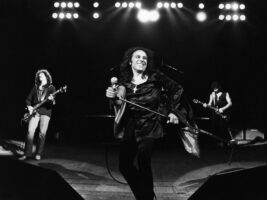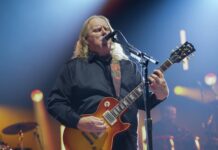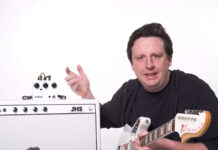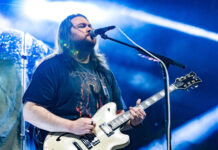
The guitar gear used by Tony Iommi on Black Sabbath’s Heaven & Hell album
2025 has been a bittersweet time for Black Sabbath fans – seeing the band unite for one last time before Ozzy Osbourne’s tragic and unexpected passing just weeks later will go down as one of the most poignant moments in the history of rock.
READ MORE: The guitar influences of Kurt Cobain
But such was the irreplaceable power of Ozzy as a frontman, it’s easy to forget that when he left the band in 1979 to build a legendary solo career peppered with some of the finest guitar-slingers around, Sabbath continued. If there’s an on-record bright spot in this post-Ozzy Black Sabbath period, it’s probably the immediate aftermath when Ronnie James Dio stepped in to front the band.
Heaven & Hell was the first album Sabbath recorded with Dio, released in 1980 and recorded across the previous year with the original Iommi/Ward/Butler dream team backing Dio up. After this record, Bill Ward would leave the band temporarily, and Geezer Butler would do likewise a few years later – kicking off a period of constant personnel upheaval for Sabbath that wouldn’t really settle until the original line-up reformed in 1997.
It’s understandably led to the post-Ozzy Sabbath records to not be well regarded, but Heaven & Hell is an exception. It features some of the best riffs and guitar sounds that Iommi had put on record since the early Sabbath records, this is what he used to make it.
Guitars: An SG Masterclass
Iommi’s main guitar for Heaven and Hell was the SG-type that is most commonly associated with him today, an instrument he lovingly refers to as “Old Boy”. Old Boy was originally built in 1975 as a backup to another custom SG-style guitar that John Birch had built for Iommi. Old Boy was built by John Diggins, who worked for John Birch, and had been asked to tour the US as a guitar tech for Tony. The guitar was meant to serve as not only a backup guitar, but as a platform for him to experiment with different pickups while on tour.
Due to time constraints before leaving for the tour, Old Boy was built by Diggins at home on his kitchen counter over the course of only a week or two. Due to the rush to get it done before the US tour, the finish didn’t have enough time to cure, which led to its distressed look – it was also later left in a car in Brazil on a very hot day and the finish bubbled up, resulting in the look we see today.
The pickups were swapped out a fair amount in the early days before settling on the pickups Iommi liked best. They are, of course, John Diggins custom pickups – the neck was modeled after a John Birch Magnum X – even using a John Birch casing. The bridge was a total custom Diggins pickup. All of Tony’s guitars have the bridge tone pot disconnected. The guitar, at one time had a booster circuit, which was soon removed. Old Boy also features an additional output jack which served as a low impedance output for recording purposes. That was later disconnected. The guitar features cross inlays and a zero fret.
Old Boy was used on overdubs for Heaven and Hell and was the main weapon of choice on every album after that. Diggins built Tony another SG in 1981 as a spare to Old Boy. It featured dual rail humbuckers, and what many believe was a Kahler 2300 tremolo.
So, what guitar was used for the main tracks? The most likely culprit was a cherry red customized left-handed Gibson SG that Iommi dubbed “Monkey”. Monkey was used from the very first album through the classic era lineup. Old Boy was made as a successor to Monkey, but it seems likely that Tony was still using Monkey in the studio during the initial sessions for Heaven and Hell. The neck pickup in that guitar is a John Birch custom pickup and the bridge is a Gibson P-90 that was fitted into a metal casing, again, by John Birch. These are the most likely guitars used on the album.
Amplifiers
Iommi’s amplifiers of choice during that era, and much of his career, were the Laney Supergroups. The folks at Laney seem to recall Iommi getting some of the early prototypes, but we can’t confirm that those amps made it to Iommi prior to the recording of Heaven and Hell. The Supergroup was generally used in conjunction with a Dallas Arbiter Rangemaster Treble Booster, which drove the amps a bit harder on the front end.
However, Iommi claimed in an interview with Vintage Guitar Magazine that for Heaven and Hell, he used a modded Marshall, specifically a 1959 model, which eliminated the need for a Treble Boost, as he stated in the interview:
“On Heaven and Hell, I used a Marshall [model 1959 Super Lead], and effects in the studio were a delay, certainly, on the solo bit for Heaven and Hell. … I had John ‘Dawk’ Stillwell come in – he used to build Ritchie Blackmore’s amps – and he lived with us while we were writing and recording in Miami. We had six Marshalls that he rebuilt with an extra stage, so they were a bit more potent than a regular Marshall. He’d done away with the treble booster I had forever. I was really not happy about that (laughs). He’d thrown it away, and I didn’t know. He said, ‘You don’t need that. You just go straight into the amp.’ Which is what I did.”
The addition of an extra preamp tube as a gain stage was not an uncommon modification to those Marshall amplifiers in that era. Jose Arredondo was well known for performing this modification. While Arredondo performed the mod for the rockstars on the west coast, Stillwell performed the same mod for British rockers like Iommi and Blackmore (he also worked for Richie Sambora). There is no evidence that the two amp gurus ever met, but the modifications they did were very similar, with a common objective.
Elsewhere in the Vintage Guitar interview, Iommi said the only effects he used on the album were a chorus, a delay, and a wah, although he didn’t go into detail about what models he used. However, Tony has historically been partial to the Tychobrahe Parapedal for the wah, which debuted in the mid-1970s.
Legacy
The album Heaven and Hell remains a gem in the Black Sabbath catalogue, despite not featuring the classic lineup. The album remained a great platform for Tony Iommi to further showcase his brilliant guitar wizardry, this time amidst the very different vocal style of Ronnie James Dio. It added an element of depth and variety to what we now know as the Black Sabbath sound.
The post The guitar gear used by Tony Iommi on Black Sabbath’s Heaven & Hell album appeared first on Guitar.com | All Things Guitar.
Source: www.guitar-bass.net













